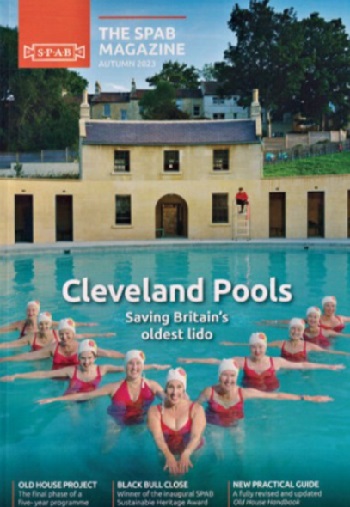SPAB Magazine autumn 2023
The educational remit and fostering of craft skills plays a key part of what the SPAB does. The autumn 2023 issue of the SPAB Magazine emphasises this role, which is illustrated by the approach to the philosophy and practice of traditional repair and maintenance across a range of buildings. Some of them post-date its statutory casework remit of buildings ostensibly dating before 1720.
The magazine references the new SPAB initiative aimed at addressing the shortage of the home-produced hazel thatching spars that hold straw or reed in place on roofs. Hazel spars are a by-product of coppicing hazel, as part of traditional woodland management. Spar making in the UK has declined and thatchers have relied heavily on spars imported from Poland. This supply has dwindled for a variety of reasons, including increased transport costs, and has become unreliable and intermittent. Although plastic spars are available, they are non-traditional and environmentally unsound, and the society does not advocate their use. However, without spars thatchers cannot thatch, so there is a pressing need to revitalise the production of home-grown hazel spars. The society is working with the National Trust, the National Coppice Federation, groups representing thatchers and the IHBC, to recruit the support of conservation officers for this initiative.
The SPAB continues to promote its exemplary practical Old House Project at St Andrew’s, Boxley in Kent. An article in the present issue explains the approach to research, investigation, community engagement, and identifying and devising appropriate repairs. The works are now well advanced and 2023-24 is the final year of work. On completion, the SPAB hopes that St Andrew’s will be exemplary not only in terms of conservation and sustainability, but also as an appealing place to live, complete with contemporary comforts, compatible with its listed status and the society’s repair philosophy. Completion will enable the society to repay an AHF Heritage Impact Fund loan, which was the first of a new stream of support that incentivises community engagement.
The issue also covers the tellingly illustrated, SPAB sustainable heritage award winner at Blackpool Bull Close, Dunbar. There the focus has been on reusing existing materials, replicating methods from residual evidence, and sourcing new materials as locally as possible to create an authentic low-carbon and mostly plastic-free rebuild. Again, the works reflect the society’s ethos, and the project was also found to inspire greater community cohesion, empowerment, urban regeneration, training and development, and the principles of the circular economy.
Although straying somewhat beyond the 1720 date of its statutory remit, the current issue also celebrates the exceptional achievement of reclaiming the 200-year old outdoor bathing pools at Cleveland, Bristol, after a 19-year campaign. The baths originally opened in 1817, but by 1975 Bath Council had built a new sports and leisure centre in the city centre, fed by the famous thermal springs, and in a programme of rationalisation it closed the pools in 1978. They briefly reopened in 1983 and 1984, only soon to be virtually forgotten, despite their Grade I listing. The long road back to successful regeneration has not been helped by the impact of Covid, but the imaginative approach to funding included an ability to tap into the public-sector decarbonisation fund. This, and the importance of sustained voluntary effort, are all explained in this inspiring case study.
This article originally appeared in the Institute of Historic Building Conservation’s (IHBC’s) Context 178, published in December 2023.
--Institute of Historic Building Conservation
Related articles on Designing Buildings
IHBC NewsBlog
Old Sarum fire in listed (& disputed) WW1 Hangar - Wiltshire Council has sought legal advice after fire engulfed a listed First World War hangar that was embroiled in a lengthy planning dispute.
UK Antarctic Heritage Trust launches ‘Virtual Visit’ website area
The Trust calls on people to 'Immerse yourself in our heritage – Making Antarctica Accessible'
Southend Council pledge to force Kursaal owners to maintain building
The Council has pledged to use ‘every tool in the toolbox’ if urgent repairs are not carried out.
HE’s Research Magazine publishes a major study of the heritage of England’s suburbs
The article traces the long evolution of an internal programme to research 200 years of suburban growth
IHBC Context 183 Wellbeing and Heritage published
The issue explores issues at the intersection of heritage and wellbeing.
SAVE celebrates 50 years of campaigning 1975-2025
SAVE Britain’s Heritage has announced events across the country to celebrate bringing new life to remarkable buildings.
IHBC Annual School 2025 - Shrewsbury 12-14 June
Themed Heritage in Context – Value: Plan: Change, join in-person or online.
200th Anniversary Celebration of the Modern Railway Planned
The Stockton & Darlington Railway opened on September 27, 1825.
Competence Framework Launched for Sustainability in the Built Environment
The Construction Industry Council (CIC) and the Edge have jointly published the framework.
Historic England Launches Wellbeing Strategy for Heritage
Whether through visiting, volunteering, learning or creative practice, engaging with heritage can strengthen confidence, resilience, hope and social connections.















